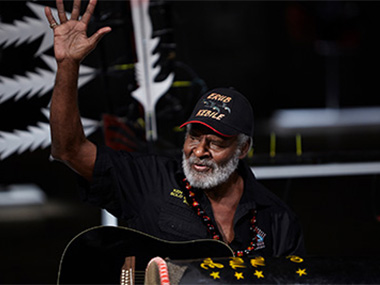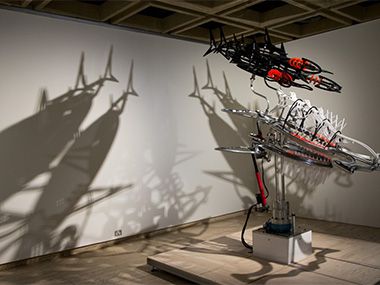Red Ochre for Ken Thaiday

Dr Ken Thaiday Sr Photo: Zan Wimberley
Posted by Jeremy Eccles | 28.05.17
The delightfully modest Ken Thaiday Snr from the Torres Strait has taken out Indigenous culture's most important award – the 2017 Red Ochre. Selected by his peers and managed by the Australia Council, no Torresian has been recognised since 2005, when folk singer, Seaman Dan won. And Dr Thaiday is the first ever visual artist recipient from the TSI.
Ken Thaiday's multidisciplinary practice integrates visual art and installation, kinetic sculpture, dance and song inspired by the landscape of his Torres Strait birthplace on the island he still calls Darnley, and is rooted in cultural customs and traditional forms using contemporary materials.
Ken is best known for his extraordinary and elaborate ‘dance machines’, elaborate mask headdresses. These include representations of the Beizam (hammerhead shark), which is his family totem, as well as works that contemporise the traditional form of the Dari. The Dari is a headdress historically worn by Torres Strait warriors in battle. It is a potent symbol of the Torres Strait Island people, appearing on their flag and enduring today as a sign of peace and harmony.
Perhaps the most remarkable aspect of Ken’s interpretation of the traditional mask headdresses is his ingenious reimagining of them as kinetic sculptures that, when worn by a dancer, bring to life the dances, songs and stories of a seafaring people where lessons about nature and the environment were essential to survival. Ken’s innovative articulated headdresses allow dancers to mobilise the various totemic artefacts he creates, and move them to his choreography using a complex system of pulleys and strings so that wings of birds can flap and the mouth of a shark can open and close.
“When I'm dancing and wearing the Dari, I become the shark”, he has said. “From my observation, I'm showing how it comes up to get the live bait by simulating its jaw movements. The hammerhead shark as ‘the king of the saltwater’ and the symbol of law and order for us”.
Born in 1950 on Erub (Darnley Island) in the eastern group of the TSI, Ken Thaiday is from the Meriam Mer peoples. He went to school on Thursday Island and when he was 15, he and his family went to Tully on the mainland.
Ken takes up the story at this point:
“My father, Tat Thaiday was a great Dari maker on Darnley, though his father had come from New Caledonia. Jimmy Lifou married my grandma from Murray Island - and she was a queen. So, because of her, my name is unquestioned, and they all call me Uncle. Old Kaike Mabo even called me Uncle; and when I asked 'why?', he said, 'Because of your grandma'.
“But, on the mainland, I started work with Queensland Rail, boiling the billy as a 'nipper boy'. By 19, I was a labourer, and then a leading hand, when Dick Anstey the boss called me 'Number Two Steel Game Kabile' and told the others to pay attention to what I said. Later I went to Wittenoon in West Australia to work in Lang Hancock's asbestos mine - when Gina was still a skinny girl! I saw dust in the air, and though we wore masks, I just couldn't breath. Funnily enough, my legs are bad, but my lungs are still OK. You know, we used to use asbestos slates to kill fish! You'd throw one into a mass of sardines and cut three or four heads off”.
Working on the railways and in the mines gave Ken experience at assembling and dissembling the moving parts of machinery, which has proved an invaluable part of his art work. “I love doing mobile things in my art today”, he told me, “though there was no tradition of it – I invented the strings to make things move. I used to use lawyer cane and boze rope, then I moved on to kapa - iron sheeting, cut to shape. And by the time I made my giant Dari in Sydney (at Carriageworks) last year, I used PVC pipes with the help of a plumber.
“But a couple of years ago, young Jason (Christopher) came up to Cairns to find me with the idea that we could mechanise my dance machines. There was a really beautiful one (Beizam Triple Hammer Head Shark) in the Sydney Biennale last year. And then we started making an even bigger Dari for the show in Monaco (Taba Naba at the Oceanographic Museum) out of aluminium”. That 4.6 metre work is now in Canberra at the NGA's Indigenous Triennial, while an outsize aluminium clam-shell there opens and closes as a TSI flag-decorated sun rises and falls.
This is a reference to the Coming of the Light – the name given to the arrival of Christian missionaries at Kernus on Erub Island in 1871. It's a significant part of Thaiday's life. “Dad ran the re-enactment of that event on Darnley, but, as a little boy, I only joined in the dancing. But Dad knew I was going to be somebody someday, and now I run the re-enactment as Dabad – head of the tribe. It helps to keep Darnley in my heart – my nerkep. I love my island, and there's often its little white church on the side of my artworks”.
Ken returned to Cairns in the late 80s and established the Loza Dance Group with other Torres Strait Islanders, beginning his art practice.
“This Red Ochre Award is something special to win – I've applied many times for it, and the Telstra – but I never seemed to get in, while Dennis (Nona) and Alick (Tipoti – fellow TSI artists) always got chosen. So I deserve the Award, especially after being in hospital for three months with my leg. I need the money too ($50,000) for new fishing gear – that's something I still like to do”.
Also awarded at the 10th National Indigenous Arts Awards in Sydney was Lynette Narkle, with a first-ever second Red Ochre Award added to celebrate the 50 years since the 1967 Referendum (and privately funded). The Noongar actress from WA did so much to bring the plays of Jack Davis alive and has gone on to direct Perth's Yirra Yakin Theatre Company. Actor and singer Lisa Maza, daughter of the late, great Red Ochre winner, Bob Maza, received a Fellowship to develop her career as a producer; and poet/singer, Ancestress/Teila Watson received the Dreaming Award to take her Brisbane-based career forward.
Share this:
»  del.icio.us
»
del.icio.us
»  Digg it
»
Digg it
»  reddit
»
reddit
»  Google
»
Google
»  StumbleUpon
»
StumbleUpon
»  Technorati
»
Technorati
»  Facebook
Facebook
Contact Details

Ken Thaiday Snr in collaboration with Jason Christopher at the 2016 Biennale of Sydney. 'Beizam Triple Hammer Head Shark', (2016), cast aluminium, stainless steel, aluminium extrusion, steel, Perspex, rubber, electronic components, computer system and aud

One of Ken Thaiday's dance machines in action at Carriageworks in 2016
Further Research
Artists: Alick Tipoti | Dennis Nona | Ken Thaiday Snr
News Tags: Australia Council | Gina Hancock | Jeremy Eccles | Ken Thaiday | Lynette Narkle | NGA Triennial | Red Ochre Awards | Sydney Biennale | Torres Strait Islands
News Categories: Art Prize | Blog | Event | Industry | News | Reception
Exhibition Archive
- 10.10.17 | TARNANTHI 2017
- 11.08.17 | Natsiaas 2017
- 20.07.17 | APY ART DOMINATES THE WYNNE
- 17.07.17 | Anangu Artist Wins $100,000 Prize
- 14.07.17 | The End of AAMU
- 11.07.17 | ART ACROSS THE COUNTRY
- 11.07.17 | TARNANTHI IN OCTOBER
- 05.07.17 | TJUNGUṈUTJA - from having come together
- 13.06.17 | Ghost-Nets Straddle the World
- 07.06.17 | Grayson Perry Going Indigenous?
- 05.06.17 | Barks Bigger than Ben Hur
- 27.05.17 | NGA QUINQUENNIAL 2017
- 21.05.17 | Blak Douglas Finds Home at the NGA
- 21.05.17 | BRIAN ROBINSON WINS HAZELHURST WOP
- 18.05.17 | PARRTJIMA 2.0
Advertising

